Optimal Effects of Combined Application of Nitrate and Ammonium Nitrogen Fertilizers with a Ratio of 3:1 on Grain Yield and Water Use Efficiency of Maize Sowed in Ridge–Furrow Plastic Film Mulching in Northwest China
Abstract
:1. Introduction
2. Materials and Methods
2.1. Experimental Site
2.2. Soil of the Experimental Site
2.3. Experimental Treatments and Methodology
2.4. Growth Parameters and Dry Matter Accumulation
2.5. Soil Water Calculations
2.6. Crop Water Use
2.7. Grain Yield, Harvest Index, and Water Use Efficiency
2.8. Statistical Analysis
3. Results
3.1. Growth of Maize Plants under Different Nitrogen Fertilizer and Cultivation Practices
3.2. Dry Matter Accumulation
3.3. Soil Water Content
3.4. Evapotranspiration
3.5. Yield Components
3.6. Grain Yield, Harvest Index, Water Use Efficiency, and Partial Factor Productivity
3.7. Correlation Analysis
4. Discussion
5. Conclusions
Supplementary Materials
Author Contributions
Funding
Institutional Review Board Statement
Informed Consent Statement
Data Availability Statement
Acknowledgments
Conflicts of Interest
References
- Li, S.X.; Wang, Z.H.; Li, S.Q.; Gao, Y.J. Effect of nitrogen fertilization under plastic mulched and non-plastic mulched conditions on water use by maize plants in dryland areas of China. Agr. Water Manag. 2015, 162, 15–32. [Google Scholar] [CrossRef]
- Zhang, L.; Zhu, X.Q.; Heerink, N.; Shi, X.P. Does output market development affect irrigation water institutions? Insights from a case study in northern China. Agr. Water Manag. 2014, 131, 70–78. [Google Scholar] [CrossRef] [Green Version]
- Zhang, S.L.; Sadras, V.; Chen, X.P.; Zhang, F.S. Water use efficiency of dryland maize in the Loess Plateau of China in response to crop management. Field Crops Res. 2014, 163, 55–63. [Google Scholar] [CrossRef]
- Liu, Q.F.; Chen, Y.; Liu, Y.; Wen, X.X.; Liao, Y.C. Coupling effects of plastic film mulching and urea types on water use efficiency and grain yield of maize in the Loess Plateau, China. Soil Till. Res. 2016, 157, 1–10. [Google Scholar] [CrossRef]
- Guo, Q.Q.; Love, J.; Roche, J.; Song, J.; Turnbull, M.H.; Jameson, P.E. A RootNav analysis of morphological changes in Brassica napus L. roots in response to different nitrogen forms. Plant Growth Regul. 2017, 83, 83–92. [Google Scholar] [CrossRef]
- Cui, Z.J.; Guo, L.Z.; Gao, Y.H.; Li, C.C.; Peng, Z.D.; Liu, H.S.; Niu, J.Y. Response of water consumption characteristics and grain yield of maize to different nitrogen form ratio with full ridge-furrow plastic film mulching and planting in furrows. Chin. J. Appl. Ecol. 2019, 30, 3426–3434. [Google Scholar]
- Wang, Z.H.; Miao, Y.F.; Li, S.X. Effect of ammonium and nitrate nitrogen fertilizers on wheat yield in relation to accumulated nitrate at different depths of soil in drylands of china. Field Crops Res. 2015, 183, 211–224. [Google Scholar] [CrossRef]
- Fan, Z.Q.; Wang, Z.Q.; Wu, C.; Sun, H.L.; Xu, W.J.; Huo, C.F. Nitrogen and biomass partitioning pattern in root and leaf of Fraxinus mandshurica seedlings. Chin. Agric. Sci. Bull. 2008, 24, 45–51. [Google Scholar]
- Elwan, M.; El-Hamed, K. Influence of nitrogen form, growing season and sulfur fertilization on yield and the content of nitrate and vitamin c of broccoli. Sci. Hortic. 2011, 127, 181–187. [Google Scholar] [CrossRef]
- Wang, P.; Wang, Z.K.; Sun, X.C.; Mu, X.H.; Chen, H.; Chen, F.J.; Yuan, L.X.; Mi, G.H. Interaction effect of nitrogen form and planting density on plant growth and nutrient uptake in maize seedlings. J. Integr. Agric. 2019, 18, 1120–1129. [Google Scholar] [CrossRef]
- Zebarth, B.J.; Tai, H.; Luo, S.; Millard, P.; Koeyer, D.D.; Li, X.Q.; Xiong, X.Y. Effect of nitrogen form on gene expression in leaf tissue of greenhouse grown potatoes during three stages of growth. Am. J. Potato Res. 2012, 89, 315–327. [Google Scholar] [CrossRef]
- Lan, G.P.; Shi, L.M.; Lu, X.Y.; Liu, Z.Y.; Sun, Y. Effects of dopamine on antioxidation, mineral nutrients, and fruit quality in cucumber under nitrate stress. J. Plant Growth Regul. 2022, 41, 2918–2929. [Google Scholar] [CrossRef]
- Borgognone, D.; Colla, G.; Rouphael, Y.; Cardarelli, M.; Rea, E.; Schwarz, D. Effect of nitrogen form and nutrient solution pH on growth and mineral composition of self-grafted and grafted tomatoes. Sci. Hortic. 2013, 149, 61–69. [Google Scholar] [CrossRef]
- Ke, J.; Pu, W.X.; Wang, H.; Liu, L.H.; Sheng, S. Phenotypical evidence of effective amelioration of ammonium-inhibited plant (root) growth by exogenous low urea. J. Plant Physiol. 2020, 255, 153306. [Google Scholar] [CrossRef]
- Britto, D.T.; Kronzucker, H.J. NH4+ toxicity in higher plants: A critical review. J. Plant Physiol. 2002, 159, 567–584. [Google Scholar] [CrossRef] [Green Version]
- Roosta, H.R.; Schjoerring, J.K. Effects of ammonium toxicity on nitrogen metabolism and elemental profile of cucumber plants. J. Plant Nutr. 2007, 30, 1933–1951. [Google Scholar] [CrossRef]
- Marschner, H. Marschner’s Mineral Nutrition of Higher Plants; Academic Press: Berlin, Germany, 2011. [Google Scholar]
- Calderón-Vázquez, C.; Sawers, R.J.; Herrera-Estrella, L. Phosphate deprivation in maize: Genetics and genomics. Plant Physiol. 2011, 156, 1067–1077. [Google Scholar] [CrossRef] [PubMed] [Green Version]
- FAO. FAOSTAT (Online). Available online: http://www.fao.org/faostat/en/#home (accessed on 6 April 2021).
- Zheng, J.; Fan, J.L.; Zou, Y.F.; Henry, W.C.; Zhang, F.C. Ridge-furrow plastic film mulching with a suitable planting density enhances rainwater productivity, grain yield and economic benefit of rainfed maize. J. Arid Land. 2020, 12, 181–198. [Google Scholar] [CrossRef]
- Jia, Q.M.; Sun, L.F.; Shahzad, A.; Zhang, Y.; Liu, D.H.; Kamran, M.; Zhang, P.; Jia, Z.K.; Ren, X.L. Effect of planting density and pattern on maize yield and rainwater use efficiency in the Loess Plateau in China. Agr. Water Manag. 2018, 202, 19–32. [Google Scholar] [CrossRef]
- Yang, F.K.; He, B.L.; Zhang, G.P.; Zhang, L.G.; Gao, Y.P. Impacts of different soil fertility improvement practices with film mulched ridge-furrow tillage on soil nutrient content, maize yield, and water use efficiency in Northwest China. Chin. J. Appl. Ecol. 2019, 30, 893–905. [Google Scholar]
- Xue, Y.F.; Zhang, H.; Xia, H.Y.; Wang, Q.C.; Wen, L.Y.; Xue, Y.H.; Yu, Z.G.; Li, Z.X. Effect of different nitrogen forms on the dry weight and nitrogen accumulation of maize seedlings. J. Maize Sci. 2016, 24, 126–130. [Google Scholar]
- Fan, M.S.; Li, Z.; Wang, F.M.; Zhang, J.H. Growth and phosphorus uptake of oat (Avenanuda L.) as affected by mineral nitrogen forms supplied in hydroponics and soil culture. Pedosphere 2019, 19, 323–330. [Google Scholar] [CrossRef]
- Guo, S.; Zhou, Y.; Shen, Q.; Zhang, F. Effect of ammonium and nitrate nutrition on some physiological processes in higher plants-growth, photosynthesis, photorespiration, and water relations. Plant Biol. 2005, 9, 21–29. [Google Scholar] [CrossRef] [PubMed]
- Niu, L.; Yan, Y.Y.; Hou, P.; Bai, W.B.; Zhao, R.L.; Wang, Y.H.; Li, S.K.; Du, T.S.; Zhao, M.; Song, J.Q.; et al. Influence of plastic film mulching and planting density on yield, leaf anatomy, and root characteristics of maize on the Loess Plateau. Crop J. 2020, 8, 548–564. [Google Scholar] [CrossRef]
- Li, C.C.; Gao, Y.H.; Guo, L.Z.; Liu, H.S. Effects of different ratios of nitrate to ammonium on dry matter accumulation and yield of maize planting in furrows under alternating narrow and wide ridges completely mulched. Agric. Res. Arid Areas 2017, 35, 198–203, 296. [Google Scholar]
- Li, C.C.; Gao, Y.H.; Guo, L.Z.; Liu, H.S.; Li, Y.; Yang, T.Q.; Ke, J. Effects of different forms and ratios of nitrogen on nutrient accumulation and transfer of whole plastic-film mulching on double ridges and planting in catchment furrows of maize. J. Maize Sci. 2018, 26, 134–141. [Google Scholar]
- Zerulla, W.; Barth, T.; Dressel, J.; Erhardt, K.; Locquenghien, K.H.V.; Pasda, G.; Rädle, M.; Wissemeier, A. 3,4-Dimethylpyrazole phosphate (DMPP)—A new nitrification inhibitor for agriculture and horticulture. Biol. Fert. Soils 2001, 34, 79–84. [Google Scholar] [CrossRef]
- Liu, C.A.; Jin, S.L.; Zhou, L.M.; Jia, Y.; Li, F.M.; Xiong, Y.C.; Li, X.G. Effects of plastic film mulch and tillage on maize productivity and soil parameters. Eur. J. Agron. 2009, 31, 241–249. [Google Scholar] [CrossRef]
- Shirley, L.; Li, L.L.; Xie, J.H.; Zhang, R.Z.; Luo, Z.Z.; Cai, L.Q. Soil respiration and net ecosystem production under different tillage practices in semi-arid Northwest China. Plant Soil Environ. 2017, 64, 14–21. [Google Scholar] [CrossRef] [Green Version]
- Wang, F.; Xie, R.Z.; Ming, B.; Wang, K.R.; Hou, P.; Chen, J.L.; Liu, G.Z.; Zhang, G.Q.; Xue, J.; Li, S.K. Dry matter accumulation after silking and kernel weight are the key factors for increasing maize yield and water use efficiency. Agr. Water Manag. 2021, 254, 106938. [Google Scholar] [CrossRef]
- Xie, J.H.; Wang, L.L.; Li, L.L.; Jeffrey, A.C.; Chai, Q.; Zhang, R.Z.; Luo, Z.Z.; Carberry, P.; Rao, K.P.C. Subsoiling increases grain yield, water use efficiency, and economic return of maize under a fully mulched ridge-furrow system in a semiarid environment in China. Soil Till. Res. 2020, 199, 104584. [Google Scholar] [CrossRef]
- Gao, Y.; Fan, J.; Peng, X.P.; Wang, L.; Mi, M.X. Soil water depletion and infiltration under the typical vegetation in the water-wind erosion crisscross region. Acta Ecol. Sin. 2014, 34, 7038–7046. [Google Scholar]
- Dar, E.A.; Brar, A.S.; Singh, K.B. Water use and productivity of drip irrigated wheat under variable climatic and soil moisture regimes in North-West. India Agric. Ecosyst. Environ. 2017, 248, 9–19. [Google Scholar] [CrossRef]
- Xie, G.; Han, D.; Wang, X.; Lv, R. Harvest index and residue factor of cereal crops in China. J. China Agric. Univ. 2011, 16, 1–8. [Google Scholar]
- Deng, Z.; Bai, D.; Zhai, G.; Zong, J.; Li, Y.; Cai, J. Effects of water and nitrogen regulation on the yield and water and nitrogen use efficiency of cotton in south Xinjiang, Northwest China under plastic mulched drip irrigation. Chin. J. Appl. Ecol. 2013, 24, 2525–2532. [Google Scholar]
- Mo, F.; Li, X.Y.; Niu, F.J.; Zhang, C.R.; Li, S.K.; Zhang, L.; Xiong, Y.C. Alternating small and large ridges with full film mulching increase linseed (Linum usitatissimum L.) productivity and economic benefit in a rainfed semiarid environment. Field Crop Res. 2018, 219, 120–130. [Google Scholar] [CrossRef]
- Zhang, X.D.; Yang, L.C.; Xue, X.K.; Kamran, M.; Ahmad, I.; Dong, Z.Y.; Liu, T.N.; Jia, Z.K.; Zhang, P.; Han, Q.F. Plastic film mulching stimulates soil wet-dry alternation and stomatal behavior to improve maize yield and resource use efficiency in a semi-arid region. Field Crop Res. 2019, 233, 101–113. [Google Scholar] [CrossRef]
- Thidar, M.; Gong, D.Z.; Mei, X.R.; Gao, L.L.; Li, H.R.; Hao, W.P.; Gu, F.X. Mulching improved soil water, root distribution and yield of maize in the Loess Plateau of Northwest China. Field Crop Res. 2020, 241, 106340. [Google Scholar] [CrossRef]
- Zheng, J.; Fan, J.L.; Zhou, M.H.; Zhang, F.C.; Liao, Z.Q.; Lai, Z.L.; Yan, S.C.; Guo, J.J.; Li, Z.J.; Xiang, Y.Z. Ridge-furrow plastic film mulching enhances grain yield and yield stability of rainfed maize by improving resources capture and use efficiency in a semi-humid drought-prone region. Agr. Water Manag. 2022, 269, 107654. [Google Scholar] [CrossRef]
- Qin, S.H.; Zhang, J.L.; Dai, H.L.; Wang, D.; Li, D.M. Effect of ridge-furrow and plastic-mulching planting patterns on yield formation and water movement of potato in a semi-arid area. Agr. Water Manag. 2014, 131, 87–94. [Google Scholar] [CrossRef]
- Chang, J.; Liu, D.; Cao, H.Q.; Chang, S.X.; Wang, X.Y.; Huang, C.C.; Ge, Y. NO3−/NH4+ ratios affect the growth and N removal ability of Acorus calamus and Iris pseudacorus in a hydroponic system. Aquat. Bot. 2010, 93, 216–220. [Google Scholar] [CrossRef]
- Duan, C.X.; Chen, G.J.; Hu, Y.J.; Wu, S.F.; Feng, H.; Dong, Q.G. Alternating wide ridges and narrow furrows with film mulching improves soil hydrothermal conditions and maize water use efficiency in dry sub-humid regions. Agr. Water Manag. 2020, 245, 106559. [Google Scholar] [CrossRef]
- Ochieng, I.O.; Gitari, H.I.; Mochoge, B.; Rezaei-Chiyaneh, E.; Gweyi, J.O. Optimizing maize yield, nitrogen efficacy and grain protein content under different n forms and rates. J. Soil Sci. Plant Nut. 2021, 21, 1867–1880. [Google Scholar] [CrossRef]
- Zhang, P.; Wei, T.; Han, Q.F.; Ren, X.L.; Jia, Z.K. Effects of different film mulching methods on soil water productivity and maize yield in a semiarid area of China. Agr. Water Manag. 2020, 241, 106382. [Google Scholar] [CrossRef]
- Liu, Y.; Yang, S.J.; Li, S.Q.; Chen, X.P.; Chen, F. Growth and development of maize (Zea mays L.) in response to different field water management practices: Resource capture and use efficiency. Agric. For. Meteorol. 2010, 150, 606–613. [Google Scholar]
- Jampeetong, A.; Brix, H.; Kantawanichkul, S. Effects of inorganic nitrogen form on growth, morphology, N uptake, and nutrient allocation in hybrid Napier grass (Pennisetum purpureum × Pennisetum americanum cv. Pakchong1). Ecol. Eng. 2014, 73, 653–658. [Google Scholar] [CrossRef]
- Qian, X.Q.; Shen, Q.R.; Xu, G.H. Water utilization by rice growing in aerobic soil supplied with different ratio of NH4+-N and NO3−-N NO3−-N. Acta Pedol. Sin. 2003, 40, 894–900. [Google Scholar]
- Zhang, X.D.; Zhao, J.; Yang, L.C.; Kamran, M.; Xue, X.K.; Dong, Z.Y.; Jia, Z.K.; Han, Q.F. Ridge-furrow mulching system regulates diurnal temperature amplitude and wetting-drying alternation behavior in soil to promote maize growth and water use in a semiarid region. Field Crops Res. 2019, 233, 121–130. [Google Scholar] [CrossRef]
- Fang, H.; Li, Y.N.; Gu, X.B.; Yu, M.; Du, Y.D.; Chen, P.P.; Li, Y.P. Evapotranspiration partitioning, water use efficiency, and maize yield under different film mulching and nitrogen application in northwest China. Field Crops Res. 2021, 264, 108103. [Google Scholar] [CrossRef]
- Liu, C.A.; Zhou, L.M.; Jia, J.J.; Li, F.M. Maize yield and water balance is affected by nitrogen application in a film-mulching ridge–furrow system in a semiarid region of China. Eur. J. Agron. 2014, 52, 103–111. [Google Scholar] [CrossRef]
- Gan, Y.T.; Siddique, K.H.M.; Turner, N.C.; Li, X.G.; Niu, J.Y.; Yang, C.; Liu, L.P.; Chai, Q. Ridge-furrow mulching systems-an innovative technique for boosting crop productivity in semiarid rain-fed environments-chapter seven. Adv. Agron. 2013, 118, 429–476. [Google Scholar]
- Zhang, S.; Simelton, E.; LÖvdahl, L.; Grip, H.; Chen, D.L. Simulated long-term effects of different soil management regimes on the water balance in the Loess Plateau, China. Field Crops Res. 2007, 100, 311–319. [Google Scholar] [CrossRef]
- Alpha, J.M.; Chen, J.H.; Zhang, G.P. Effect of nitrogen fertilizer forms on growth, photosynthesis, and yield of rice under cadmium stress. J. Plant Nutr. 2009, 32, 306–317. [Google Scholar] [CrossRef]
- Sun, D.B.; Li, H.G.; Wang, E.L.; He, W.Q.; Hao, W.P.; Yan, C.R.; Li, Y.Z.; Mei, X.R.; Zhang, Y.Q.; Sun, Z.X.; et al. An overview of the use of plastic-film mulching in China to increase crop yield and water-use efficiency. Natl. Sci. Rev. 2020, 7, 1523–1526. [Google Scholar] [CrossRef] [PubMed]
- Xue, N.W.; Xue, J.F.; Yang, Z.P.; Sun, M.; Ren, A.X.; Gao, Z.Q. Effects of film mulching regime on soil water status and grain yield of rain-fed winter wheat on the Loess Plateau of China. J. Integr. Agr. 2017, 16, 2612–2622. [Google Scholar] [CrossRef]
- Wu, Y.; Jia, Z.K.; Ren, X.L.; Zhang, Y.; Chen, X.; Bing, H.Y.; Zhang, P. Effects of ridge and furrow rainwater harvesting system combined with irrigation on improving water use efficiency of maize (Zea mays L.) in semi-humid area of China. Agr. Water Manag. 2015, 158, 1–9. [Google Scholar] [CrossRef]
- Liu, D.J.; Zhang, H.J.; Qi, Q.Q.; Sun, Y.; Guo, Y.F.; Sun, G.Z.; Wang, G.J.; Yan, W.Y.; Yang, S.P.; Ma, S.M. Effects of different nitrogen nutrition forms on physiology characteristics at seedling stage of wheat. Crops 2011, 1, 20–24. [Google Scholar]
- Amanullah. Source and rate of nitrogen application influence agronomic N-use efficiency and harvest index in maize (Zea mays L.) genotypes. Maydica 2014, 59, 80–89. [Google Scholar]
- Wang, N.J.; Ding, D.Y.; Malone, R.W.; Chen, H.X.; Wei, Y.S.; Zhang, T.B.; Luo, X.Q.; Li, C.; Chu, X.S.; Feng, H. When does plastic-film mulching yield more for dryland maize in the Loess Plateau of China? A meta-analysis. Agr. Water Manag. 2020, 240, 106290. [Google Scholar] [CrossRef]
- Raquel, S.-A.; Subesh, D.; Hayat, U.; Anshul, A.; Avishek, D. Seeding, nitrogen and irrigation management optimize rice water and nitrogen use efficiency. Nutr. Cycl. Agroecosyst. 2021, 120, 325. [Google Scholar]
- Gu, X.B.; Li, Y.N.; Du, Y.D. Optimized nitrogen fertilizer application improves yield, water and nitrogen use efficiencies of winter rapeseed cultivated under continuous ridges with film mulching. Ind. Crop. Prod. 2017, 109, 233–240. [Google Scholar] [CrossRef]
- Gu, X.B.; Li, Y.N.; Du, Y.D. Continuous ridges with film mulching improve soil water content, root growth, seed yield and water use efficiency of winter oilseed rape. Ind. Crop. Prod. 2016, 85, 139–148. [Google Scholar] [CrossRef]
- Yin, Z.H.; Raven, J.A. Influences of different nitrogen sources on nitrogen- and water-use efficiency, and carbon isotope discrimination, in C3 Triticum aestivum L. and C4 Zea mays L. plants. Planta 1998, 205, 574–580. [Google Scholar] [CrossRef]
- Chen, Y.; Zhao, X.; Zhang, L.; Shen, R. Effects of NH4+ and NO3− on nitrogen efficiency and mineral nutrient contents of rice. Soils 2019, 51, 243–250. [Google Scholar]
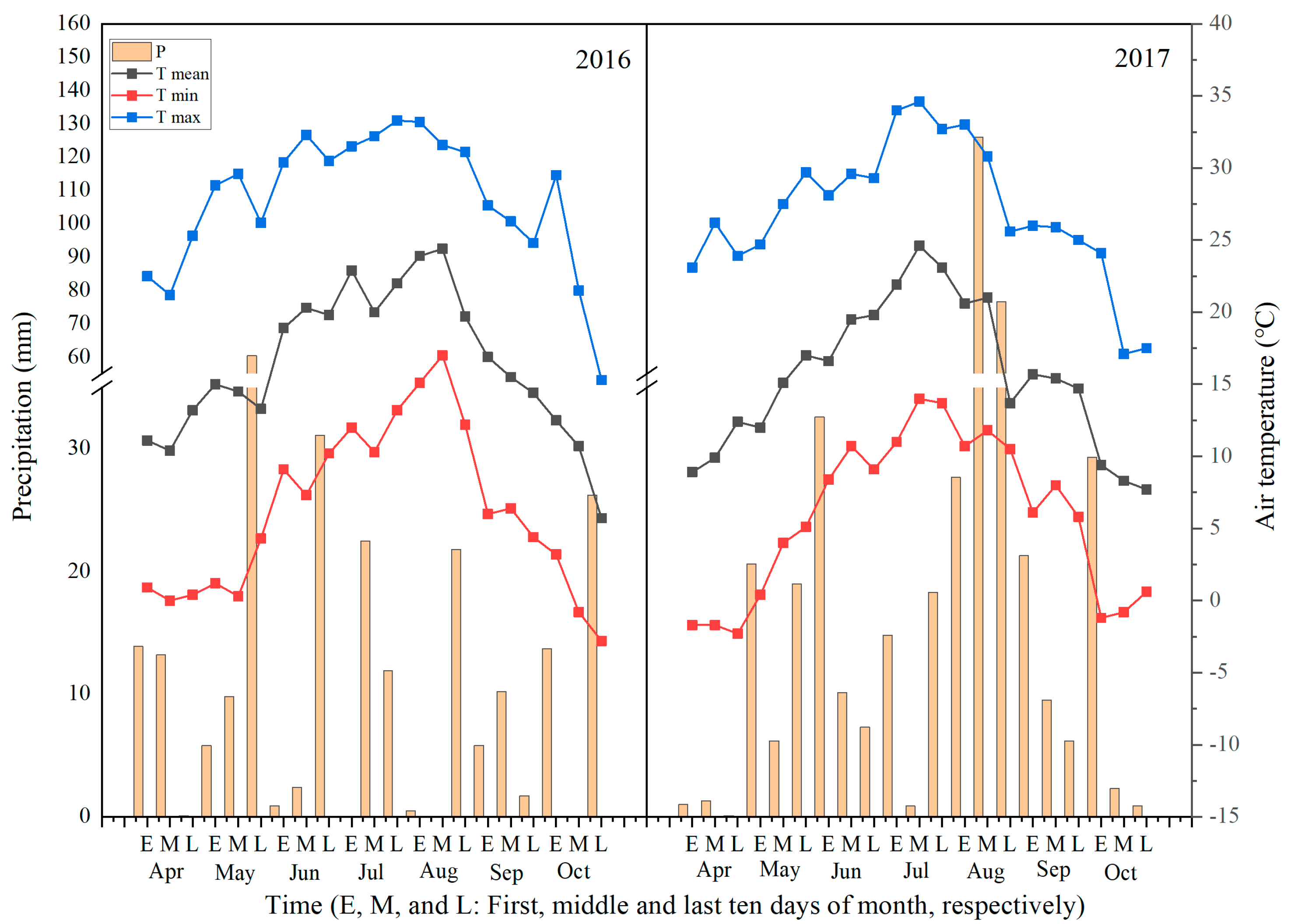
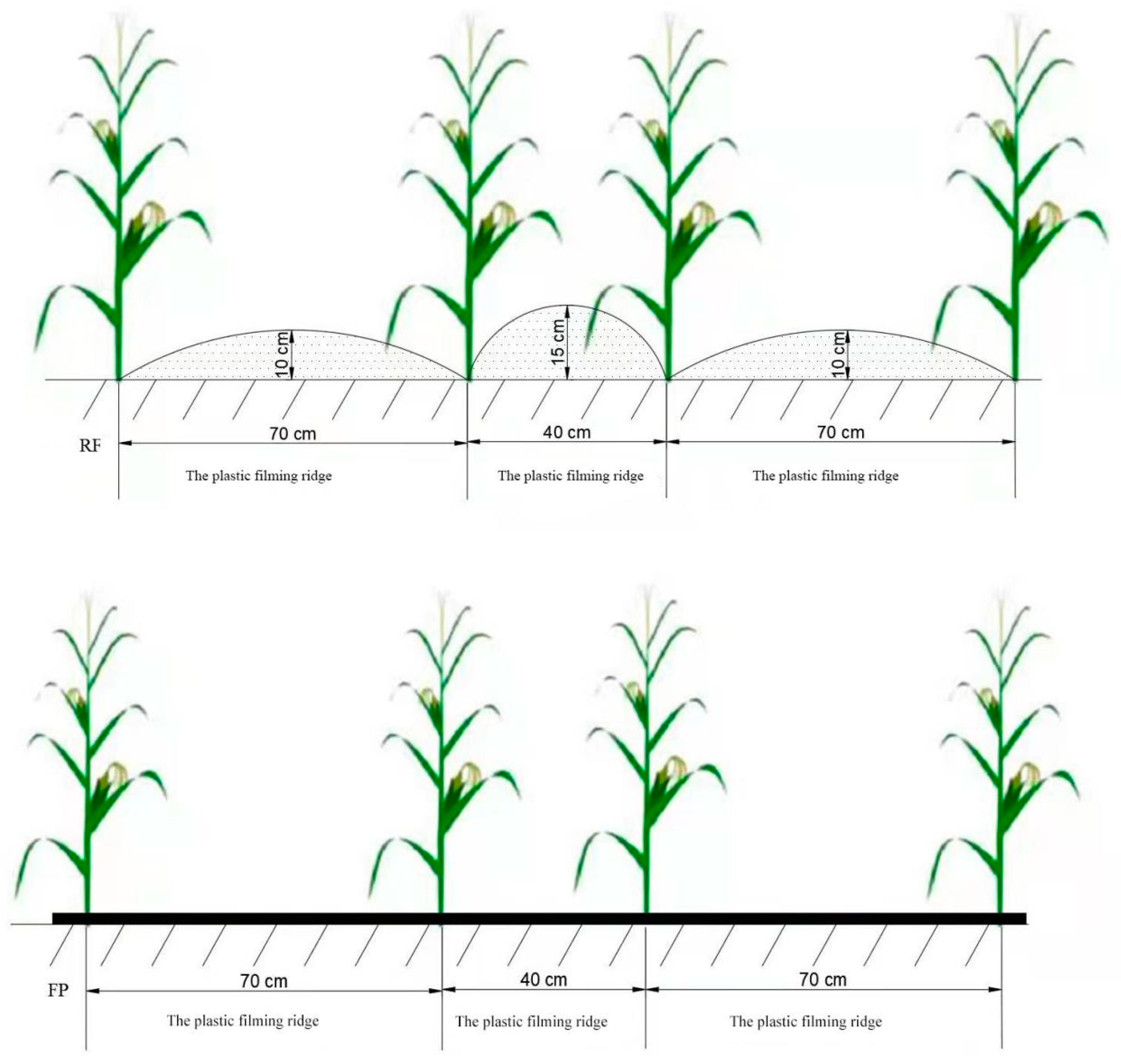
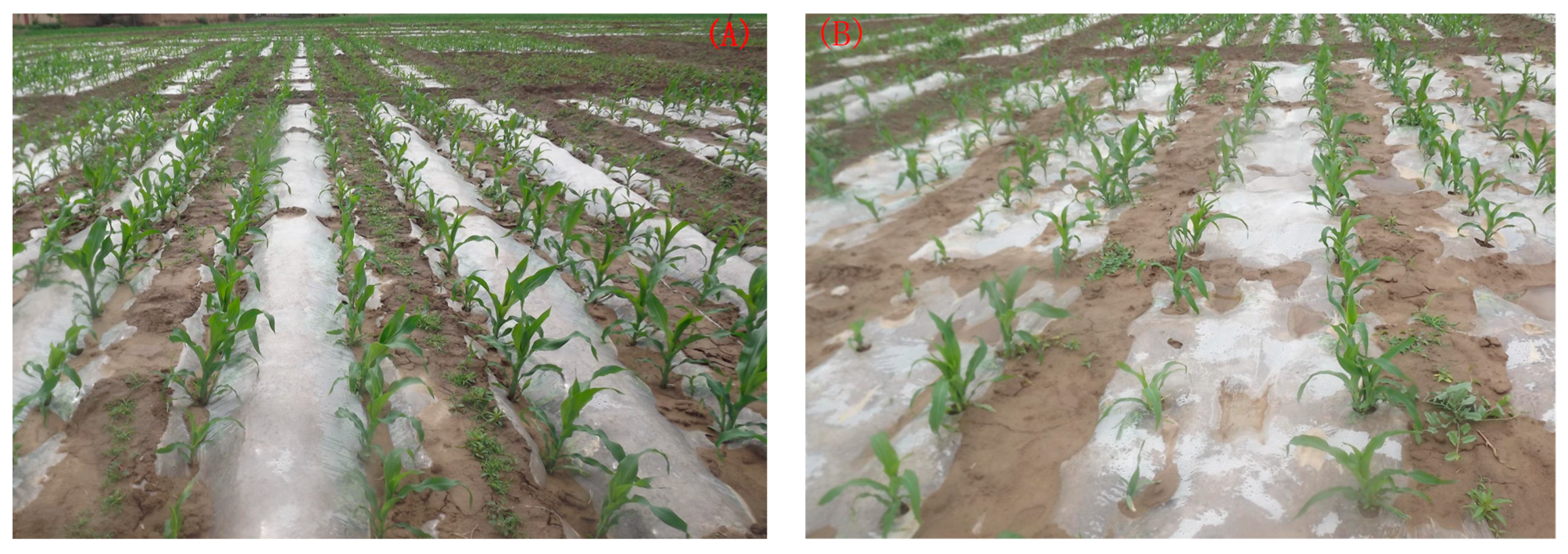
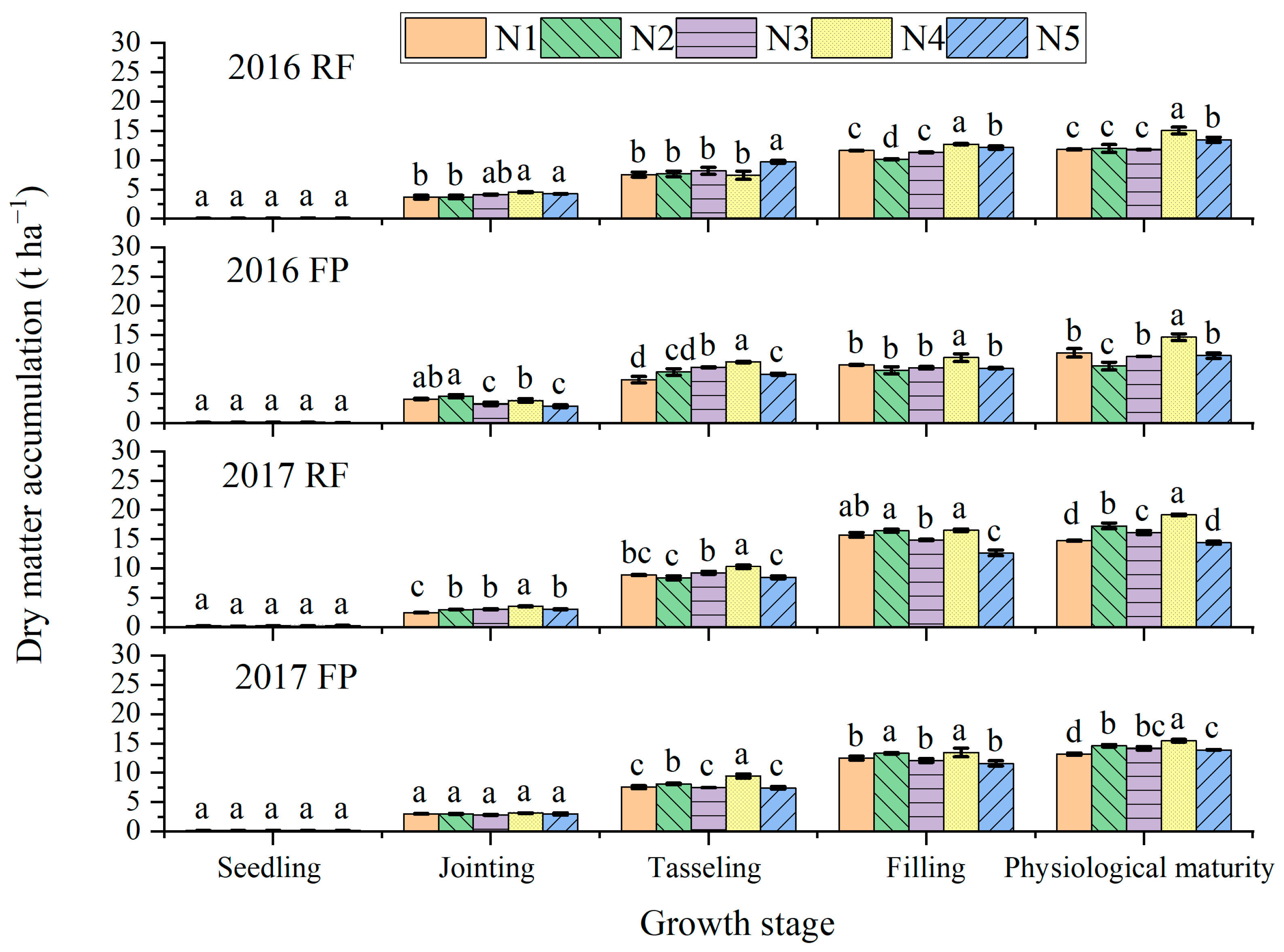

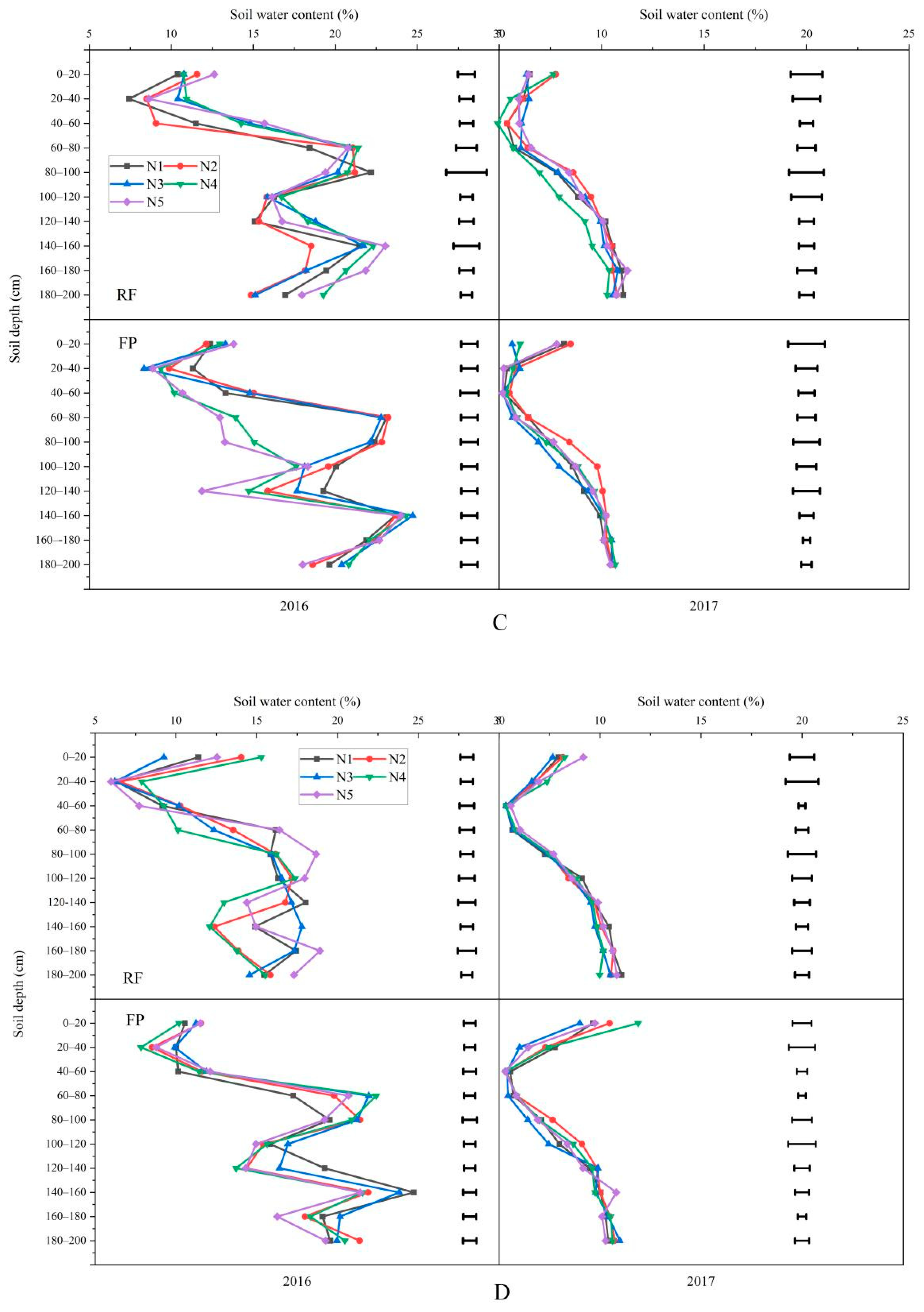
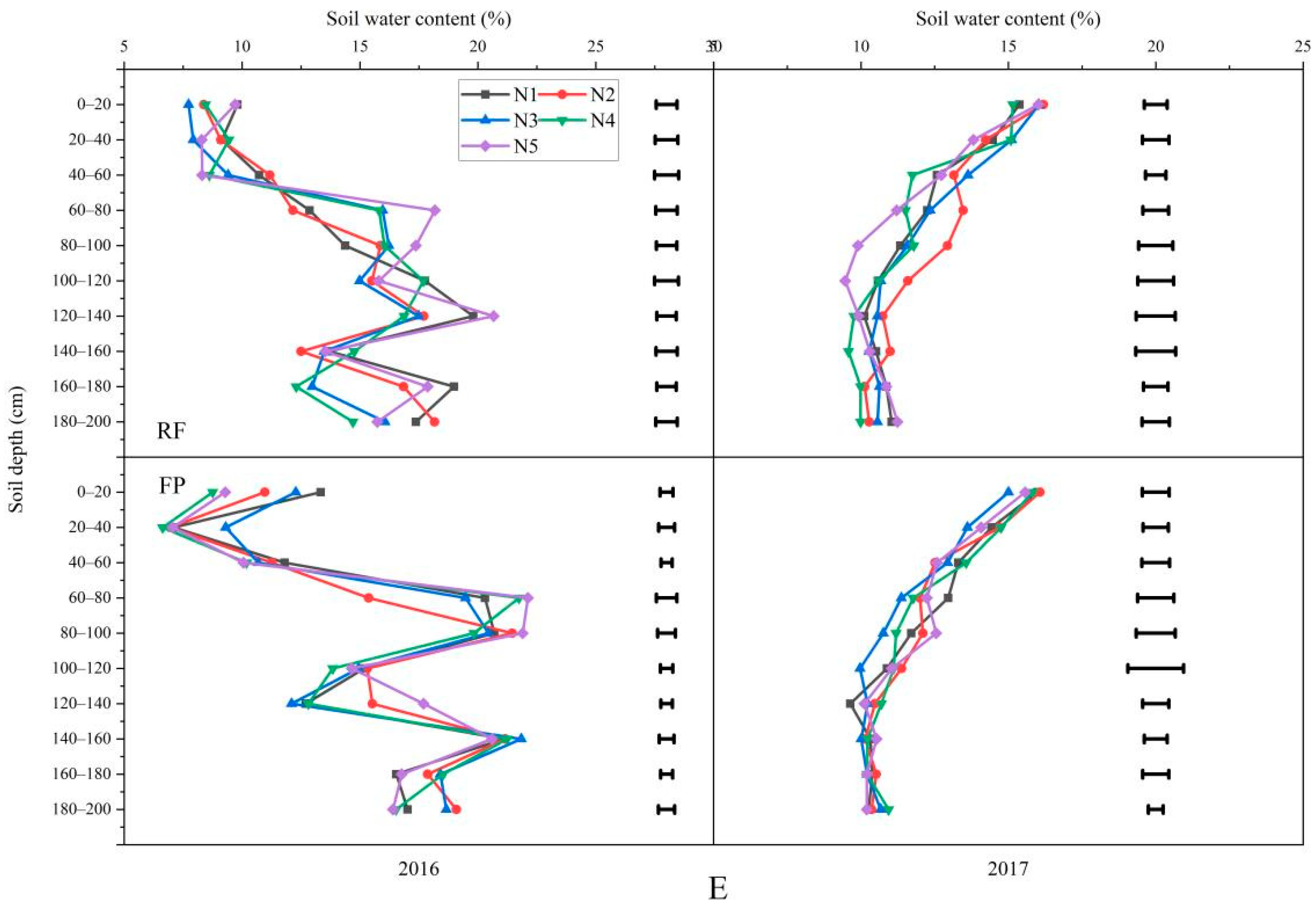
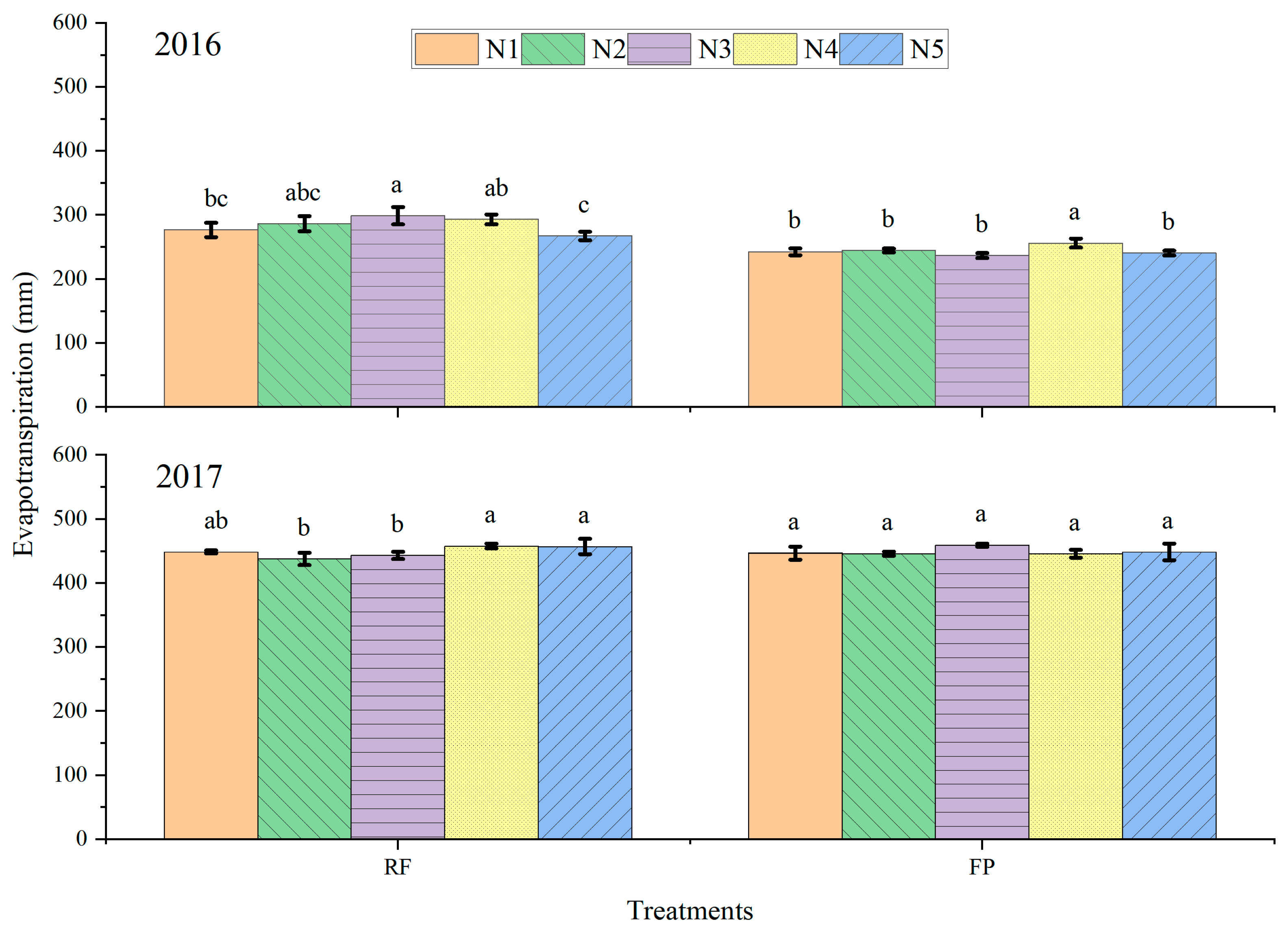
| Year | Soil Porosity | Organic Matter | Total N | Available P | Available K | pH |
|---|---|---|---|---|---|---|
| (%) | (g kg−1) | (g N kg−1) | (mg P kg−1) | (mg K kg−1) | ||
| 2016 | 54.3 | 11.96 | 0.98 | 59.87 | 5.46 | 8.17 |
| 2017 | 53.9 | 11.94 | 0.97 | 60.07 | 5.38 | 8.12 |
| Treatment | Symbol | Fertilizer Amount | DMPP (kg ha−1) ‡ | |
|---|---|---|---|---|
| KNO3 (kg ha−1) | (NH4)2SO4 (kg ha−1) | |||
| Ridge–furrow plastic film mulching | RF | n.a. | n.a. | n.a. |
| Flat planting with plastic film mulching | FP | n.a. | n.a. | n.a. |
| KNO3 fertilizer | N1 | 2221.5 | 0 | 0 |
| KNO3:(NH4)2SO4 with ratio † 1:1 | N2 | 1111.5 | 714 | 1.5 |
| KNO3:(NH4)2SO4 with ratio † 1:3 | N3 | 555 | 1071 | 2.25 |
| KNO3:(NH4)2SO4with ratio † 3:1 | N4 | 1666.5 | 357 | 0.75 |
| Urea fertilizer | N5 | 646.5 kg ha−1 Urea | 0 | |
| Treatments | Plant Height (cm) | Stem Diameter (mm) | LAI | ||||
|---|---|---|---|---|---|---|---|
| 2016 | 2017 | 2016 | 2017 | 2016 | 2017 | ||
| RF | N1 | 187.26 b | 191.00 b | 29.50 b | 28.36 c | 5.91 ab | 5.86 ab |
| N2 | 195.64 a | 200.78 ab | 30.02 ab | 29.54 b | 6.07 a | 5.99 a | |
| N3 | 196.25 a | 192.44 b | 29.88 b | 29.32 b | 5.75 b | 5.70 b | |
| N4 | 197.99 a | 208.44 a | 31.06 a | 30.78 a | 6.02 a | 6.02 a | |
| N5 | 190.55 b | 175.22 c | 29.24 b | 29.06 b | 5.62 b | 5.36 b | |
| FP | N1 | 185.67 ab | 184.67 ab | 28.85 b | 27.92 b | 5.83 ab | 5.71 ab |
| N2 | 179.26 b | 181.33 b | 28.66 b | 28.11 b | 5.70 ab | 5.66 ab | |
| N3 | 188.97 ab | 182.22 b | 28.78 b | 28.77 b | 5.49 b | 5.49 b | |
| N4 | 192.34 a | 189.22 a | 29.86 a | 29.72 a | 5.97 a | 5.91 a | |
| N5 | 182.33 b | 171.44 c | 28.55 b | 28.23 b | 5.34 b | 5.20 b | |
| CP | ** | * | * | * | ns | ns | |
| N | ** | ** | * | * | * | * | |
| CP × N | * | * | ns | ns | ns | ns | |
| Treatment | Seedling Stage | Jointing Stage | Tasseling Stage | Filling Stage | Physiological Maturity Stage | |||||
|---|---|---|---|---|---|---|---|---|---|---|
| 2016 | 2017 | 2016 | 2017 | 2016 | 2017 | 2016 | 2017 | 2016 | 2017 | |
| CP | * | *** | ** | ns | ** | *** | *** | *** | *** | *** |
| N | ns | ns | ** | *** | *** | *** | *** | *** | *** | *** |
| CP × N | ns | ns | *** | *** | *** | ** | * | ** | ** | *** |
| Year | Treatment | Spike Length | Ear Width | Ear Barren Tip | Ear Rows | Row Grains | 100-Grain Weight | |
|---|---|---|---|---|---|---|---|---|
| (Y) | (cm) | (mm) | (cm) | (rows) | (grains) | (g) | ||
| 2016 | RF | N1 | 14.24 c | 43.33 a | 2.17 a | 16.00 b | 27.11 c | 19.13 d |
| N2 | 15.03 b | 42.44 ab | 1.33 b | 16.89 a | 28.44 bc | 20.40 c | ||
| N3 | 15.67 a | 41.77 b | 1.07 c | 16.00 b | 30.89 a | 21.79 b | ||
| N4 | 15.63 a | 43.27 a | 0.83 d | 17.00 a | 31.22 a | 24.44 a | ||
| N5 | 14.83 b | 41.71 b | 1.42 b | 16.22 b | 30.22 ab | 21.76 b | ||
| FP | N1 | 14.80 ab | 40.83 b | 1.25 ab | 15.67 c | 25.56 d | 18.90 a | |
| N2 | 15.00 a | 39.64 b | 1.58 a | 16.90 a | 27.11 c | 19.54 a | ||
| N3 | 15.02 a | 40.66 b | 1.50 ab | 16.44 ab | 28.67 b | 20.35 a | ||
| N4 | 15.42 a | 42.47 a | 1.17 b | 17.00 a | 30.44 a | 20.41 a | ||
| N5 | 14.28 b | 40.60 b | 1.17 b | 16.00 bc | 30.33 a | 21.24 a | ||
| 2017 | RF | N1 | 14.80 a | 44.73 c | 0.73 b | 13.38 c | 26.00 b | 36.94 a |
| N2 | 16.50 a | 47.39 b | 1.02 ab | 18.17 b | 29.33 ab | 36.28 a | ||
| N3 | 16.75 a | 44.87 c | 0.84 b | 17.13 b | 27.63 b | 36.32 a | ||
| N4 | 17.16 a | 52.45 a | 0.80 b | 21.33 a | 32.67 a | 38.31 a | ||
| N5 | 15.89 a | 39.55 d | 1.29 a | 12.92 c | 19.50 c | 34.95 a | ||
| FP | N1 | 12.33 d | 39.73 c | 1.05 ab | 14.13 b | 18.75 c | 33.87 a | |
| N2 | 15.48 ab | 43.33 b | 1.19 ab | 15.25 ab | 21.75 b | 36.47 a | ||
| N3 | 15.19 b | 38.34 d | 1.60 a | 14.63 b | 18.58 c | 36.58 a | ||
| N4 | 16.00 a | 45.41 a | 0.75 b | 16.33 a | 26.25 a | 36.80 a | ||
| N5 | 14.31 c | 40.13 c | 1.58 a | 12.08 c | 17.58 c | 35.79 a | ||
| CP | *** | *** | * | *** | *** | * | ||
| N | *** | *** | *** | *** | *** | ** | ||
| CP × N | *** | ** | *** | * | * | ns | ||
| Year | Treatments | GY | HI | WUEb | WUEg | PFP | |
|---|---|---|---|---|---|---|---|
| (Y) | (kg ha−1) | (%) | (kg ha−1 mm−1) | (kg ha−1 mm−1) | (kg kg−1) | ||
| 2016 | RF | N1 | 5367.67 d | 45.43 b | 26.35 c | 19.44 b | 29.82 d |
| N2 | 6343.84 b | 53.09 a | 27.40 bc | 22.22 a | 35.24 b | ||
| N3 | 5751.92 c | 48.73 b | 26.65 c | 19.26 b | 31.96 c | ||
| N4 | 6779.28 a | 45.14 b | 32.90 a | 23.17 a | 37.66 a | ||
| N5 | 5104.33 d | 37.91 c | 29.51 b | 19.13 b | 28.36 d | ||
| FP | N1 | 4953.56 c | 41.60 b | 26.78 b | 20.45 b | 27.52 c | |
| N2 | 5384.80 b | 55.71 a | 21.81 c | 22.04 a | 29.92 b | ||
| N3 | 5063.21 c | 44.60 b | 24.74 b | 21.40 a | 28.13 c | ||
| N4 | 5613.71 a | 38.41 b | 32.84 a | 21.95 a | 31.19 a | ||
| N5 | 4564.73 d | 39.87 b | 25.64 b | 18.99 c | 25.36 d | ||
| 2017 | RF | N1 | 4789.29 c | 32.51 a | 32.85 d | 10.68 b | 26.61 c |
| N2 | 5531.85 b | 32.09 a | 39.48 c | 12.65 a | 30.73 b | ||
| N3 | 4401.93 d | 27.32 c | 36.42 b | 9.94 c | 24.46 d | ||
| N4 | 5990.22 a | 31.26 ab | 41.86 a | 13.08 a | 33.28 a | ||
| N5 | 4140.07 d | 28.77 bc | 31.52 d | 9.06 d | 23.00 d | ||
| FP | N1 | 4071.26 d | 30.88 a | 29.53 d | 9.12 c | 22.62 d | |
| N2 | 4719.90 b | 32.28 a | 32.81 b | 10.59 b | 26.22 b | ||
| N3 | 4352.35 c | 30.75 a | 30.87 c | 9.49 c | 24.18 c | ||
| N4 | 5009.06 a | 32.40 a | 34.71 a | 11.25 a | 27.83 a | ||
| N5 | 3812.38 e | 27.41 b | 31.04 c | 8.50 d | 21.18 e | ||
| CP | *** | ns | *** | ** | *** | ||
| N | *** | *** | *** | *** | *** | ||
| CP × N | *** | ns | *** | ** | *** | ||
| 2016 | |||||||||||
|---|---|---|---|---|---|---|---|---|---|---|---|
| Item | DM | ETa | Ear Rows | Row Grains | 100-Grain Weight | GY | HI | WUEb | WUEg | PFP | |
| 2017 | DM | 1 | 0.344 | 0.309 | 0.475 ** | 0.448 * | 0.435 * | −0.612 ** | 0.987 ** | 0.229 | 0.435 * |
| ETa | 0.004 | 1 | 0.179 | 0.402 * | 0.468 ** | 0.713 ** | 0.255 | 0.377 * | −0.057 | 0.713 ** | |
| Ear rows | 0.896 ** | −0.003 | 1 | 0.253 | 0.300 | 0.564 ** | 0.250 | 0.319 | 0.618 ** | 0.564 ** | |
| Row grains | 0.878 ** | −0.207 | 0.818 ** | 1 | 0.670 ** | 0.303 | −0.221 | 0.458 * | −0.022 | 0.303 | |
| 100-Grain Weight | 0.437 * | 0.205 | 0.360 | 0.408 * | 1 | 0.475 ** | −0.043 | 0.379 * | 0.149 | 0.475 ** | |
| GY | 0.860 ** | −0.025 | 0.812 ** | 0.807 ** | 0.389 * | 1 | 0.431 * | 0.446 * | 0.657 ** | 1.000 ** | |
| HI | 0.109 | −0.058 | 0.193 | 0.213 | 0.080 | 0.600 ** | 1 | −0.591 ** | 0.364 * | 0.431 * | |
| WUEb | 0.982 ** | −0.183 | 0.879 ** | 0.902 ** | 0.388 * | 0.849 ** | 0.118 | 1 | 0.211 | 0.446 * | |
| WUEg | 0.842 ** | −0.173 | 0.794 ** | 0.823 ** | 0.348 | 0.989 ** | 0.606 ** | 0.861 ** | 1 | 0.657 ** | |
| PFP | 0.860 ** | −0.025 | 0.812 ** | 0.807 ** | 0.389 * | 1.000 ** | 0.600 ** | 0.849 ** | .0989 ** | 1 | |
Publisher’s Note: MDPI stays neutral with regard to jurisdictional claims in published maps and institutional affiliations. |
© 2022 by the authors. Licensee MDPI, Basel, Switzerland. This article is an open access article distributed under the terms and conditions of the Creative Commons Attribution (CC BY) license (https://creativecommons.org/licenses/by/4.0/).
Share and Cite
Cui, Z.; Gao, Y.; Guo, L.; Wu, B.; Yan, B.; Wang, Y.; Liu, H.; Li, G.; Wang, Y.; Wang, H. Optimal Effects of Combined Application of Nitrate and Ammonium Nitrogen Fertilizers with a Ratio of 3:1 on Grain Yield and Water Use Efficiency of Maize Sowed in Ridge–Furrow Plastic Film Mulching in Northwest China. Agronomy 2022, 12, 2943. https://doi.org/10.3390/agronomy12122943
Cui Z, Gao Y, Guo L, Wu B, Yan B, Wang Y, Liu H, Li G, Wang Y, Wang H. Optimal Effects of Combined Application of Nitrate and Ammonium Nitrogen Fertilizers with a Ratio of 3:1 on Grain Yield and Water Use Efficiency of Maize Sowed in Ridge–Furrow Plastic Film Mulching in Northwest China. Agronomy. 2022; 12(12):2943. https://doi.org/10.3390/agronomy12122943
Chicago/Turabian StyleCui, Zhengjun, Yuhong Gao, Lizhuo Guo, Bing Wu, Bin Yan, Yifan Wang, Hongsheng Liu, Gang Li, Yingze Wang, and Haidi Wang. 2022. "Optimal Effects of Combined Application of Nitrate and Ammonium Nitrogen Fertilizers with a Ratio of 3:1 on Grain Yield and Water Use Efficiency of Maize Sowed in Ridge–Furrow Plastic Film Mulching in Northwest China" Agronomy 12, no. 12: 2943. https://doi.org/10.3390/agronomy12122943





